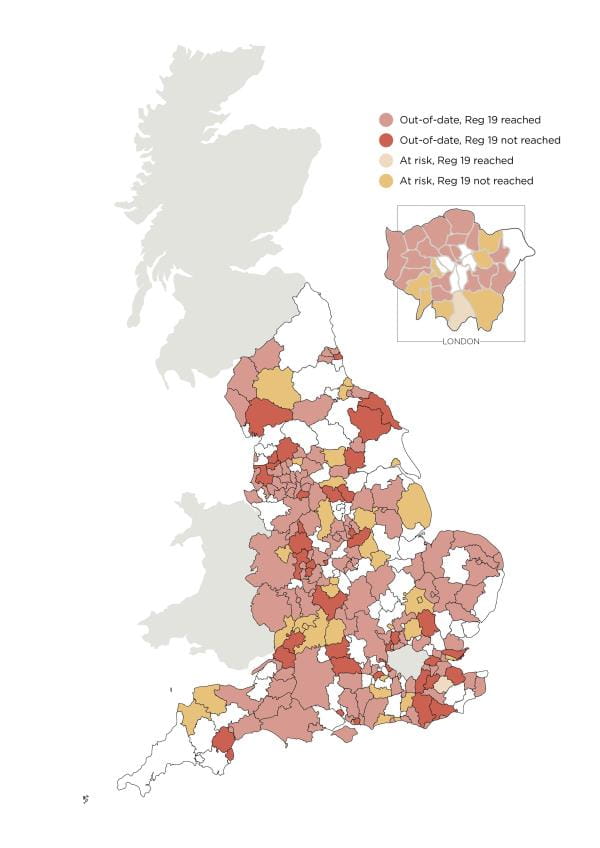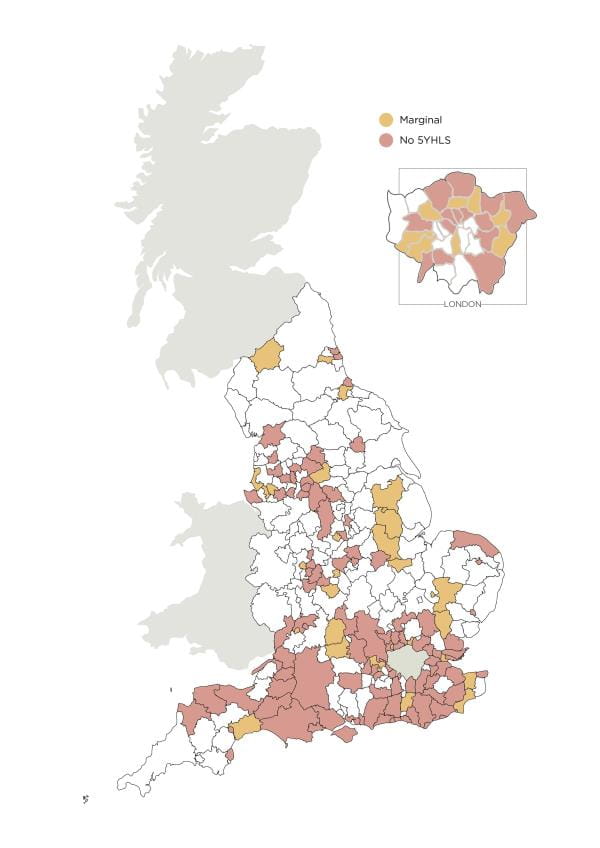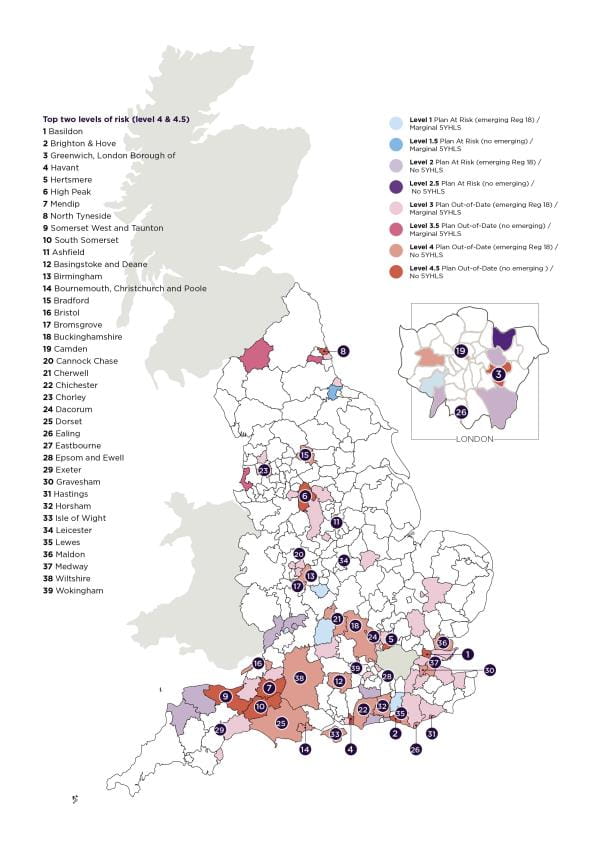In support of planning reforms in the Levelling Up and Regeneration Bill, the Government has announced plans to remove the requirement of local planning authorities (LPAs) to maintain a rolling five-year housing supply (5YHLS) – where LPAs have a Development Plan that is up-to-date (i.e. adopted within the last five years).
Paragraph 74 of the National Planning Policy Framework currently requires LPAs to identify and update annually evidence that they have a sufficient supply of land to meet housing need over a five-year period.
The level of need is established by either the housing requirement set out in adopted strategic policies, or local housing need as calculated by the Standard Methodology. The latter is only used where strategic policies are more than five years old (and therefore considered ‘out-of-date’) – unless they have been reviewed and found not to require updating. A buffer is then added to this need, ranging from 5% (to ensure choice and competition in the market for land) to 20% (where there has been significant under delivery of housing over the previous three years). The buffer is influenced by the results of the Government’s Housing Delivery Test, which assesses for each LPA a 3-year period of housing delivery against established need.
To establish supply, an LPA must identify sufficient land that is capable of meeting the established need – with reference to the definition of “deliverable” provided in Annex 2 of the NPPF.
The concept of 5YHLS has not been far from controversy, with many commentators suggesting its presence too often results in planning permission being achieved on unallocated sites that work to undermine the ‘plan-led’ system. Nevertheless, the concept of a demonstrating a 5YHLS is not new. It was first introduced under the New Labour Government in 2006 via planning practice guidance (PPS3) and was subsequently threaded into the NPPF in 2012 by the Conservative Government, forming a significant policy approach in significantly boosting the supply of housing. Accordingly, it is an important way to measure the success and continued deliverability of local plans.
In the context of the proposed removal, Carter Jonas has examined the present status of all 309 English LPAs (excluding the National Park Authority’s) and their Local Plan and 5YHLS position, using data included in our Live Local Plan Monitor and corroborated through external resources. All data is correct as of July 2022.

What LPA’s currently have out-of-date strategic policies related to housing need?
191 LPAs (62%) currently have an ‘out-of-date’ Development Plan Document (DPD) that defines housing need. In other words, the most recent DPD containing such strategic policies was adopted in July 2017 or earlier. These LPAs are shown on the above map in shades of red.
Of these 191, the relevant DPDs of 82 LPAs (43%) were last updated 10 or more years ago – predating the NPPF.
Of the 191, just over a third (65 LPAs) are currently preparing an emerging DPD that has reached at least Regulation 19 stage in preparation. These are shown in a lighter shade of red. The remaining 126 LPAs have not yet reached an advanced stage of production. These are shown in a darker shade of red.
The latter are clearly more at risk of being affected by the Government’s proposals through not having a relevant up-to-date DPD. The majority of these LPAs (86%) have reached at least Regulation 18 stage in the preparation of an up-to-date, emerging DPD. However, 26 LPAs (14%) are in the position of either not having publicly announced an emerging DPD, have postponed or cancelled the preparation of an emerging DPD, or are yet to reach at least a Regulation 18 consultation.
The Government has set a deadline of December 2023 for all LPAs in England to have in place an up-to-date Local Plan. We have therefore taken this as a litmus test to identify further LPAs which might be considered ‘at risk’ of having an out-of-date DPD, with this timescale aligning with the likely assent of the Bill. We have conservatively listed those LPAs that have not reached at least Regulation 19 or further in the production of a document including strategic housing policies.
The relevant DPD of 40 LPAs are due to expire by December 2023. Of these 40, only two (Croydon and Maidstone) have reached at least Regulation 19 stage in preparation. Of the remaining 38, nearly half (17 LPAs) of these LPAs are in the position of either not having publicly announced an emerging DPD, has postponed/cancelled preparation, or is yet to reach at least a Regulation 18 consultation.

What LPA’s do not currently have a 5YHLS?
119 LPAs (39%) cannot currently demonstrate a 5YHLS. This has either been established by a published position or confirmed at an appeal.
A further 44 LPAs (14%) possess what we have conservatively considered to be a ‘marginal’ 5YHLS, equating to 5.5 years or below.
Unsurprisingly, most LPAs that cannot demonstrate a 5YHLS, or at most a marginal position, are subject to significant spatial, environmental or physical constraints – including ongoing nutrient neutrality advice (almost 50% of total identified areas); Green Belt designation (55% of all LPAs with Green Belt); and other constraints – including Areas of Outstanding Natural Beauty, National Park and coastline.

What LPA’s are most prone to the Government’s proposals?
Using the individual data related to Local Plans and 5YHLS outlined above, Carter Jonas has identified eight ‘levels’ of threat. This exists only where an LPA has both an out-of-date or at risk Local Plan, or no or marginal level of 5YHLS.
- Level 1: ‘At Risk’ of being out-of-date and at least Regulation 18 reached; marginal 5YHLS
- Level 1.5: ‘At Risk’ of being out-of-date with no emerging DPD; marginal 5YHLS
- Level 2: ‘At Risk’ of being out-of-date and at least Regulation 18 reached; no 5YHLS
- Level 2.5: ‘At Risk’ of being out of date with no emerging DPD; no 5YHLS
- Level 3: ‘Out-of-date’ but at least Regulation 18 reached; marginal 5YHLS
- Level 3.5: ‘Out-of-date’ and no emerging DPD; marginal 5YHLS
- Level 4: ‘Out-of-date’ but at least Regulation 18 reached; no 5YHLS
- Level 4.5: ‘Out-of-date’ and no emerging DPD; no 5YHLS
|
|
|
|
LPA |
Threat Level |
|
Basildon |
4.5 |
|
Brighton & Hove |
4.5 |
|
Greenwich, London Borough of |
4.5 |
|
Havant |
4.5 |
|
Hertsmere |
4.5 |
|
High Peak |
4.5 |
|
Mendip |
4.5 |
|
North Tyneside |
4.5 |
|
Somerset West and Taunton |
4.5 |
|
South Somerset |
4.5 |
|
|
|
|
Ashfield |
4 |
|
Basingstoke and Deane |
4 |
|
Birmingham |
4 |
|
Bournemouth, Christchurch and Poole |
4 |
|
Bradford |
4 |
|
Bristol |
4 |
|
Bromsgrove |
4 |
|
Buckinghamshire |
4 |
|
Camden |
4 |
|
Cannock Chase |
4 |
|
Cherwell |
4 |
|
Chichester |
4 |
|
Chorley |
4 |
|
Dacorum |
4 |
|
Dorset |
4 |
|
Ealing |
4 |
|
Eastbourne |
4 |
|
Epsom and Ewell |
4 |
|
Exeter |
4 |
|
Gravesham |
4 |
|
Hastings |
4 |
|
Horsham |
4 |
|
Isle of Wight |
4 |
|
Leicester |
4 |
|
Lewes |
4 |
|
Maldon |
4 |
|
Medway |
4 |
|
Wiltshire |
4 |
|
Wokingham |
4 |
CONCLUSIONS
Despite criticism aimed at the role 5YHLS plays in delivering development (often by appeal on unallocated sites) this “negative” aspect is a necessary fail safe to correct imperfections in a plan-led system – ensuring the delivery of sufficient levels of housing is achieved, perhaps the greatest challenge of our generation.
If the 5YHLS is to be removed, it is clear that other mechanisms need to be introduced to ensure that plan-making delivers required development. As highlighted in this analysis, it is clear this extends to questions as to how development is delivered in areas of significant constraint (e.g. Green Belt) and the clear shortfall of housing delivery against need in the south of England.
At this point in time, this proposal poses more questions than it answers, not least as views expressed by candidates in the Conservative leadership contest regarding the future of planning for housing have referenced a so-called ‘Stalinist’ approach to existing housing targets and a potential moratorium on Green Belt development. With this change (amongst others) expected to be published in a prospectus in the near future, we will be monitoring this situation closely.
Keep informed
Sign up to our newsletter to receive further information and news tailored to you.


